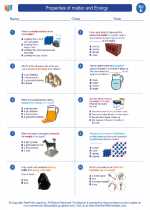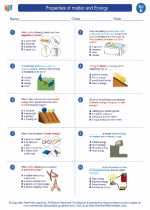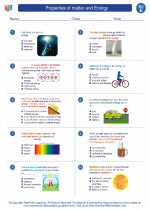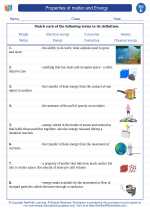Properties of matter and Energy -> nuclear energy
Nuclear Energy
Nuclear energy is the energy that is released during nuclear reactions. These reactions can be of two types: fission and fusion. Nuclear energy is a powerful and efficient source of energy, but it also comes with risks and challenges. Understanding the science behind nuclear energy is important for understanding its potential and its limitations.
Nuclear Reactions
Nuclear reactions involve changes to the nuclei of atoms. In fission, the nucleus of an atom is split into smaller parts, releasing energy in the process. In fusion, the nuclei of two atoms are combined to form a larger nucleus, also releasing energy. Both fission and fusion reactions release large amounts of energy compared to typical chemical reactions.
Nuclear Power Plants
Nuclear power plants use the heat generated from nuclear reactions to produce steam, which in turn drives turbines to generate electricity. The fuel used in these reactions is typically uranium or plutonium. These power plants provide a significant amount of the world's electricity, but they also produce radioactive waste that needs to be carefully managed.
Pros and Cons of Nuclear Energy
Nuclear energy has several advantages, including its high energy density, low greenhouse gas emissions, and reliability. However, it also comes with risks such as the potential for accidents, the production of radioactive waste, and the proliferation of nuclear weapons. Understanding and weighing these pros and cons is essential for making informed decisions about the use of nuclear energy.
Study Guide
- What are the two types of nuclear reactions?
- How do nuclear power plants generate electricity?
- What are some advantages of nuclear energy?
- What are some risks and challenges associated with nuclear energy?
- What are the primary fuels used in nuclear reactions?
By understanding the science and implications of nuclear energy, we can make informed decisions about its use and its role in our energy future.
[Nuclear Energy] Related Worksheets and Study Guides:
.◂Science Worksheets and Study Guides Fifth Grade. Properties of matter and Energy

 Worksheet/Answer key
Worksheet/Answer key
 Worksheet/Answer key
Worksheet/Answer key
 Worksheet/Answer key
Worksheet/Answer key
 Vocabulary/Answer key
Vocabulary/Answer key
 Vocabulary/Answer key
Vocabulary/Answer key
